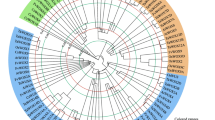Abstract
Annexins interact in a calcium-dependent manner with membrane phospholipids. Although their exact function is not known, annexins have been proposed to be involved in a variety of cellular processes. To determine whether plant annexins are implicated in cell division, we have isolated cDNAs encoding annexin from TBY2 cells. Based on sequence analysis, these cDNAs fall into two families, differing mainly by deletions or insertions in their 5′- and 3′- untranslated regions. The two annexins Ntp32.1 and Ntp32.2 encoded by these cDNAs are homologous to p32 from bell pepper (Cap32.1): we propose that these Solanaceae annexins constitute a distinct type which we call Sp32 annexins. There are two genes (Ntan.1 and Ntan.2) derived from the separate progenitor species of Nicotiana tabacum and analysis of Southern blots is consistent with the presence of these two genes. We show that Sp32 transcript amounts are developmentally modulated in tobacco plants: RNA levels are highest in growing and dividing tissues. Sp32 annexin gene expression is also regulated in TBY2 cultured cells: transcripts and proteins are detected only in exponentially growing cells. In synchronized TBY2 cells, Sp32 annexin transcripts are expressed at the G2/M transition, in the M phase and at the G1/S transition. These results are the first evidence that the expression of plant annexins is modulated during the cell cycle. The Sp32 annexin proteins accumulate during the cell cycle and peak at the end of mitosis. Immunolocalization shows that the majority of Sp32 annexins is present in intercellular junctions, forming a ring structure under the plasma membrane. Since annexins are known to bind secretory vesicles during exocytosis, their localization at cell junctions suggests that annexins could be involved in cell wall maturation.
Similar content being viewed by others
References
Battey NH, James NC, Greenland AJ: cDNA isolation and gene expression of the maize annexins p33 and p35. Plant Physiol 112: 1391–1396 (1996).
Bingham PM, Levis R, Rubin GM: Cloning of DNA sequences from the white locus of D. melanogaster by a novel and general method. Cell 25: 693–704 (1981).
Calvert CM, Gant SJ, Bowles DJ: Tomato annexins p34 and p35 bind to F-actin and display nucleotide phosphodiesterase activity inhibited by phospholipid binding. Plant Cell 8: 333–342 (1996).
Chiang Y, Schneidermann MH, Vishwanatha JK: Annexin II expression is regulated during mammalian cell cycle. Cancer Res 53: 6017–6021 (1993).
Clark GB, Dauwalder M, Roux SJ: Purification and immunolocalization of annexin-like protein in pea seedlings. Planta 187: 1–9 (1992).
Clark GB, Roux SJ: Annexins of plant cells. Plant Physiol 109: 1133–1139 (1995).
Kozak M: Compilation and analysis of sequences upstream from the translation start site in eukaryotic mRNAs. Nucl Acids Res 12: 857–872 (1984).
Kumble KD, Iversen PL, Vishwanatha JK: The role of primer recognition proteins in DNA replication: inhibition of cellular proliferation by antisense oligodeoxyribonucleotides. J Cell Sci 101: 35–41 (1992).
Nagata T, nemoto Y, Hasezawa S: Tobacco BY-2 cell line as the 'HeLa' cell in the cell biology of higher plants. Int Rev Cytol 132: 1–30 (1992).
Pirck M, Hirt H, Heberle-Bors E: The cDNA sequence encoding an annexin from Medicago sativa. Plant Physiol 104: 1463–1464 (1994).
Proust J, Houlné G, Schantz M-L, Schantz R: Characterization and gene expression of an annexin during fruit development in Capsicum annuum. FEBS Lett 383: 208–212 (1996).
Raynal P, Pollard HB: Annexins: the problem of assessing the biological role for a gene family of multifunctional calcium-a,d phospholipid-binding proteins. Biochim Biophys Acta 1197: 63–93 (1994).
Reichheld J-P, Sonobe S, Clément B, Chaubet N, Gigot C: Cell cycle-regulated histone gene expression in synchronized plant cells. Plant J 7: 245–252 (1995).
Samuels AL, Giddings TH, Staehelin LA: Cytokinesis in tobacco BY-2 and root tip cells: a new model of cell plate formation in higher plants. J Cell Biol 130: 1345–1357 (1995).
Schlaepfer DD, Haigler HT: Expression of annexins as a function of cellular growth state. J Cell Biol 111: 229–238 (1990).
Schmit A-C, Endlé M-C, Lambert A-M: The perinuclear microtubule-organizing center and the synaptonemal complex of higher plants share a common antigen: its putative transfer and role in meiotic chromosomal ordering. Chromosoma 104: 405–413 (1996).
Seals DF, Randall SK: A vacuole-associated annexin protein, VCaB42, correlates with the expansion of tobacco cells. Plant Physiol 115: 753–761 (1997).
Smallwood MF, Gurr SJ, McPherson MJ, Roberts K, Bowles DJ: The pattern of plant annexin gene expression. Biochem J 281: 501–505 (1992).
Thonat C, Mathieu C, Crevecoeur M, Penel C, Gaspar T, Boyer N: Effects of a mechanical stimulation on localization of annexin-like proteins in Bryonia dioica internodes. Plant Physiol 114: 981–988 (1997).
Towbin H, Staehelin T, Gordon J: Electrophoretic transfer of proteins from polyacrylamide gels to nitrocellulose sheets: procedures and some applications. Proc Natl Acad Sci USA 76: 4350–4354 (1979).
Zhang D, Wadsworth P, Hepler PK: Dynamics of microfilaments are similar, but distinct from microtubules during cytokinesis in living, dividing plant cells. Cell Motil Cytoskel 24: 151–155 (1993).
Author information
Authors and Affiliations
Rights and permissions
About this article
Cite this article
Proust, J., Houlné, G., Schantz, ML. et al. Regulation of biosynthesis and cellular localization of Sp32 annexins in tobacco BY2 cells. Plant Mol Biol 39, 361–372 (1999). https://doi.org/10.1023/A:1006199814795
Issue Date:
DOI: https://doi.org/10.1023/A:1006199814795




